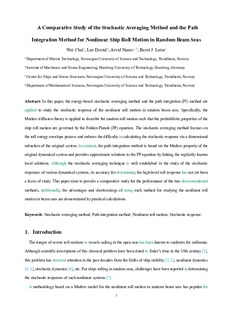A comparative study of the stochastic averaging method and the path integration method for nonlinear ship roll motion in random beam seas
Journal article, Peer reviewed
Accepted version
Permanent lenke
http://hdl.handle.net/11250/2479082Utgivelsesdato
2017Metadata
Vis full innførselSamlinger
- Institutt for marin teknikk [3471]
- Publikasjoner fra CRIStin - NTNU [38679]
Sammendrag
In this paper, the energy-based stochastic averaging method and the path integration method are applied to study the stochastic response of the nonlinear roll motion in random beam seas. Specifically, the Markov diffusion theory is applied to describe the random roll motion such that the probabilistic properties of the ship roll motion are governed by the Fokker–Planck (FP) equation. The stochastic averaging method focuses on the roll energy envelope process and reduces the difficulty in calculating the stochastic response via a dimensional reduction of the original system. In contrast, the path integration method is based on the Markov property of the original dynamical system and provides approximate solutions to the FP equation by linking the explicitly known local solutions. Although the stochastic averaging technique is well established in the study of the stochastic responses of various dynamical systems, its accuracy for determining the high-level roll response has not yet been a focus of study. This paper aims to provide a comparative study for the performance of the two above-mentioned methods; additionally, the advantages and shortcomings of using each method for studying the nonlinear roll motion in beam seas are demonstrated by practical calculations.
